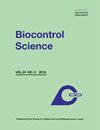Microflora of Mycotoxigenic Fungi in Rice Grains in Kyushu Region of Japan and Their Changes during Storage under non-Controlled Conditions.
IF 1.1
4区 农林科学
Q4 BIOTECHNOLOGY & APPLIED MICROBIOLOGY
引用次数: 7
Abstract
Contamination of agricultural crops by mycotoxins has increased because of the expansion of mycotoxin-producing fungi along with global warming. In this study, the fungal microflora of brown rice grains cultivated in Kyushu region in the southern part of Japan was investigated. A total of 75% of rice samples examined in this study showed less than 30% of fungal contamination rates with a median rate of 12.5%. Some isolates of Aspergillus flavus showed the ability to produce aflatoxins (AFs) (AFB1 production was 62.5-70.4 ng/mL) . Furthermore, AF-producing Aspergillus flavus survived during storage and Aspergillus creber, which produced sterigmatocystin, was detected in a stored rice sample. Although AFs or sterigmatocystin-contamination was not detected in any rice samples, these mycotoxin-producing fungi are distributed and can survive during storage under the natural conditions in Japan. Employing suitable storage conditions is important for preventing mycotoxin contamination of brown rice grains.日本九州地区稻谷产霉毒素真菌菌群及其在非控制条件下贮藏过程中的变化
由于产生真菌毒素的真菌随着全球变暖而扩大,真菌毒素对农作物的污染有所增加。本研究对日本南部九州地区栽培的糙米籽粒真菌菌群进行了调查。在本研究中,共有75%的水稻样本显示真菌污染率低于30%,中位数为12.5%。部分黄曲霉菌株显示出产生黄曲霉毒素(AFs)的能力(AFB1产量为62.5 ~ 70.4 ng/mL)。此外,产生af的黄曲霉在储存期间存活,在储存的大米样品中检测到产生sterigmatocystin的creber曲霉。虽然没有在任何水稻样品中检测到AFs或sterigmatocystin污染,但这些产生霉菌毒素的真菌在日本分布广泛,并且在自然条件下储存可以存活。选择适宜的贮藏条件是防止糙米霉菌毒素污染的重要措施。
本文章由计算机程序翻译,如有差异,请以英文原文为准。
求助全文
约1分钟内获得全文
求助全文
来源期刊

Biocontrol science
BIOTECHNOLOGY & APPLIED MICROBIOLOGY-
CiteScore
2.60
自引率
8.30%
发文量
21
审稿时长
>12 weeks
期刊介绍:
The Biocontrol Science provides a medium for the publication of original articles, concise notes, and review articles on all aspects of science and technology of biocontrol.
 求助内容:
求助内容: 应助结果提醒方式:
应助结果提醒方式:


